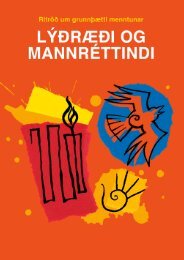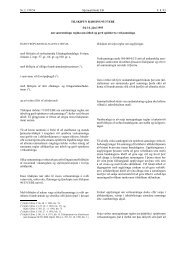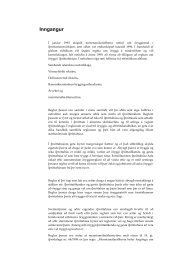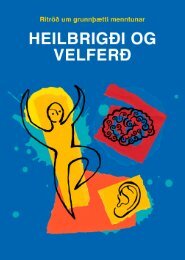Arts and Cultural Education in Iceland : Professor Anne Bamford
Arts and Cultural Education in Iceland : Professor Anne Bamford
Arts and Cultural Education in Iceland : Professor Anne Bamford
Create successful ePaper yourself
Turn your PDF publications into a flip-book with our unique Google optimized e-Paper software.
pre-primary school teachers were so helpful though I was surprised that none of the banks would do it; it is very<br />
ironic. We then had a pyjamas party for all of the people <strong>in</strong>volved <strong>and</strong> it went really well.<br />
This level of community support was equally evident away from the capital:<br />
Vignette 1.4.4 We don’t see other people <strong>and</strong> we are isolated<br />
In this town everyone gives a lot for noth<strong>in</strong>g. There are very few people so it is difficult to survive. There is not enough<br />
work for professional actors. The weather is a challenge too. It is unpredictable. Transport is hard. We don’t see other<br />
people <strong>and</strong> we are isolated. That can be a strength <strong>and</strong> a weakness to the creative process. I would say <strong>in</strong> our town<br />
the arts are bloom<strong>in</strong>g but not spread<strong>in</strong>g. There is a bit of an attitude that we are not as good<br />
here... less professional. But if you look at the academy <strong>in</strong> Reykjavik, our students are gett<strong>in</strong>g <strong>in</strong> there. So there is<br />
quality there if you look at it objectively. In this town, all the companies support the arts. There is a very high level of<br />
local support. We are lucky with this as central government is not active here. They should put more support <strong>in</strong> here.<br />
It is difficult to travel.<br />
1.5 Policy Cooperation <strong>and</strong> curriculum<br />
‣ Meet<strong>in</strong>gs should occur on a regular basis between those people responsible for culture<br />
<strong>and</strong> education at the national, municipal <strong>and</strong> local level to encourage shared strategic<br />
th<strong>in</strong>k<strong>in</strong>g <strong>and</strong> communication of good practices <strong>and</strong> <strong>in</strong>itiatives<br />
‣ The curriculum is open <strong>and</strong> flexible but <strong>in</strong> reality taught <strong>in</strong> a very similar way around<br />
the country<br />
‣ The curriculum is considered valuable for establish<strong>in</strong>g overall objectives but of less<br />
value <strong>in</strong> terms of teach<strong>in</strong>g <strong>and</strong> learn<strong>in</strong>g content <strong>and</strong> method <strong>and</strong> ways of assess<strong>in</strong>g.<br />
The M<strong>in</strong>istry of <strong>Education</strong>, Science <strong>and</strong> Culture is responsible for the policies <strong>and</strong> methods<br />
that schools must use, <strong>and</strong> they issue the National Curriculum Guidel<strong>in</strong>es. There are different<br />
types of schools:<br />
Pre-primary school or leikskóli; which are non-compulsory for children younger than six<br />
years, <strong>and</strong> is the first step <strong>in</strong> the education system.<br />
Compulsory education, or grunnskóli; which comprises primary <strong>and</strong> lower secondary<br />
education, generally conducted at the same <strong>in</strong>stitution.<br />
Upper secondary education or framhaldsskóli; which follows lower secondary education<br />
<strong>and</strong> is not compulsory.<br />
Figure 1.5.1 Percentage of budget by level of school<strong>in</strong>g<br />
Public educational expenditure, percentage breakdown by school level, 2006<br />
Pre-primary 8.2%<br />
Compulsory 49.7%<br />
Upper secondary 18.3%<br />
Higher education, tertiary level 18.2%<br />
Other 5.6%<br />
(Source: Statice, 2006)<br />
<strong>Education</strong> is m<strong>and</strong>atory by law for children aged from 6 to 16 years. All schools <strong>in</strong> Icel<strong>and</strong> are<br />
mixed sex schools.<br />
The law <strong>in</strong> Icel<strong>and</strong> is that communities are to create their own policies <strong>and</strong> each school its<br />
own curricula. The majority of schools publish their curriculum on the web <strong>and</strong> make it<br />
generally available. The most commonly provided <strong>in</strong>formation <strong>in</strong>cludes:<br />
When the school operates.<br />
Lists of subjects taught at the school.<br />
General <strong>in</strong>formation on the adm<strong>in</strong>istration of the school.<br />
19



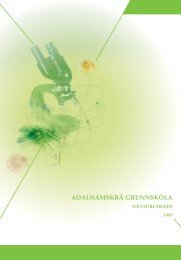
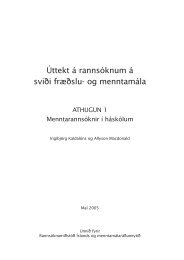

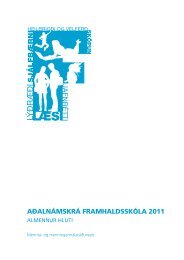
![Aðalnámskrá tónlistarskóla : rytmÃsk tónlist [Eingöngu á rafrænu formi]](https://img.yumpu.com/50843672/1/184x260/aaalnamskra-tanlistarskala-rytma-sk-tanlist-eingangu-a-rafranu-formi.jpg?quality=85)
